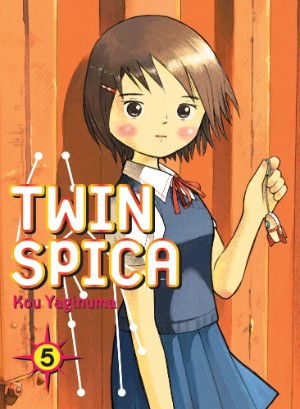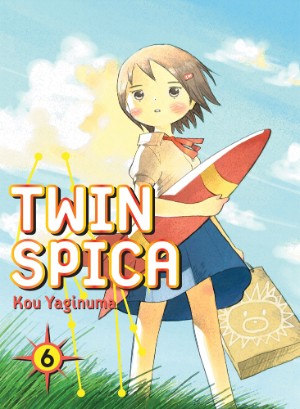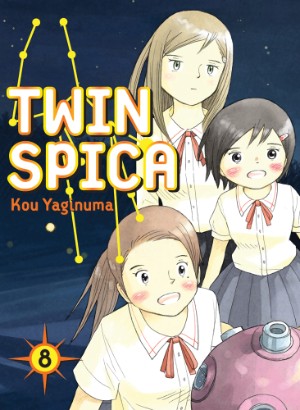So, this month we're getting To, Rideback and Blu-rays of Stand Alone Complex compilations and movie and Cowboy Bebop: Knockin' on Heaven's Door - Gundam Unicorn on DVD, the Go Nagai super robots of Mazinkaiser SKL, a new set of "real robot" great Ryousuke Takahashi's mostly not great mech vs bugs series Blue Gender . I think I'm forgetting something too...
best month for sci-fi anime in years?
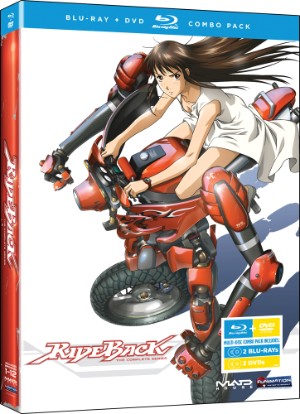
Anime Spotlight: Rideback
DVD/Blu-ray Complete Series
Released by FUNimation
Rideback works some classic formulas in a fresh fashion. There are good, interesting reasons why it can do classic formula well, and good, interesting reasons why it can do fresh well. Unfortunately, it ultimately fails to stick the landing. Even granting it some points for its membership in the underrepresented sci-fi genre, and underrepresented in North America sports genre, peaking three quarters the way through, it lacks the ultimate idea or statement that would elevate it from solid, kindof remarkable to really memorable.
The rideback of the title is a sort of highly mobile two wheeled robot/motorcycle that have attracted both sub/counter culture and military interest.
Rin Ogata was born September 11, 2001. I don't think that the anime ever makes this point, but that it is both inessential and fitting is appropriate to what the anime does. The child of a renowned ballerina, groomed and possessing the potential to be the successor to her mother's place in the spotlight, she knew of, but was isolated from the changes and troubles of the wider world. In the background, an authoritarian regime is consolidating global power, and the world is changing as a consequence, Rin's insulated from it. She's then struck by personal hardship. In 2014, her mother dies in an earthquake. In 2016, she earns a key role, but in 2017 breaks her leg. The point is made that she may or possibly may not to be able to return to the previous heights she had achieve, but she could return to the stage. Yet, she doesn't. Her father leaves the family to stage an American production, something the anime doesn't make explicit, instead just finding Rin and her adolescent brother in the care of their paternal grandmother. In 2020, as the anime opens, Rin enters the Musashina University for the Arts.
There's a highly underrated anime called Air Master, with superlative fight animation from Dragon Ball's Daisuke Nishio. It follows Maki Aikawa the 16 year old who was coached by her mother into prominence as a gymnast when she was young, but has been living alone and unmotivated since the death of her mother. The anime finds her, now over 6 feet tall, as she breaks out of a depressed haze when she discovers the stimulus of street fighting.
This story works a bit like that. Rin stumbles onto a rideback, specifically the strange Fuego model, and on it, discovers she can "dance" again. She's soon spending her time with the school's rideback club. Interest/amusingly, it is an arts school, so I think there's reference to the tech dweeb tuning the ridebacks and driving club enthusiasm being a literature major.
In sports anime/manga fashion Rin is soon butting heads with the club's aggressive veteran rider, and entering racing competitions. Except, circumstances, secrets and incautiously allowing herself to be surveyed puts Rin in the sights of the military regime's ambitions.
Manga creator Tetsuro Kasahara evidently likes cute girls and mecha... conventional enough, but he takes them into unconventional, rarely moe territory. He started off with Edison Fantasy Science, about a girl questing a post-apocalyptic landscape with blue-print producing machine "Edison Stein," from seinen, occasionally loli-ish, occasionally pretty screwed up anthology Comic Birz (Benkyo Tamaoki's Tokyo Red Hood being a classic example of both qualities). He recently did mecha series Tandem Lover for yuri (female homosexual romance) anthology Tsubomi. And, he's now doing another seinen mecha racing series, XADrunner.
Kasahara's Rideback is a cute girl mecha racing manga from Ikki. Viz is web serializing a selection from the anthology in English on their Sigikki site, and a glance will tell you that Ikki is not the home of works that evoke "oh, that's manga" responses. Instead, its manga are unconventional and radically distinct, even from each other.
The 70's played a big part in shaping modern anime and manga, whether it was Go Nagai's mecha and transforming magical girls or influential sports series like Aim for the Ace! A decade later, the 70's social climate, and its radical politics and protest movements would start filtering into anime with works with Katsuhiro Otomo's Akira and Mamoru Oshii's Patlabor.
Utilizing a 2000's perspective, as much as Rideback looks back to and updates the sports tropes of the 70's, it looks back to and updates the protest influences of the 80's. This constitutes a weird, often violent, mix of escape and reality, reflected in the way the ridebacks are both an instrument of libration and a tool of law enforcement and military forces drunk with authority and the extra empowerment of technology.
I suspect that Kasahara does enjoy drawing youngish characters, but the approach is a ways more considered than just taste or anime/manga tradition. After all, Ikki is an anthology that does in fact feature manga with adult characters.
The characters have a Mohiro Kitoh (Shadow Star/Narutaru, Bokurano: Ours) litheness to them, that makes them look discernibly young in a way that underscores their vulnerability, but, they are by no means kids. That the people involved are youthfully temperamental, naive, energetic, and also susceptible to being badly handled by the system factors into the series.
And, again, the ridebacks offer a nice juxtaposition. While they are by no means giant robots, Kasahara has a head for detailed mecha designs, and, unprotected by any enclosure, characters are pretty high of the ground on fast moving machines. As such, it's the rare anime/manga case that does convey the exhilarating danger of operating a powerful machine.
Rideback is directed by Atsushi Takahashi, who steps up from storyboard work, as well as an assistant director post on Spirited Away. He doesn't manage a dazzling series. It is notably TV scales especially given that Takahashi and Madhouse's involvement invites comparison to their bike racing theatrical anime Nasu: Summer in Andalusia. He does succeed in establishing a specific look and spirit. He gets the height, weight and speed of the rideback, such that it really seems like watching someone on top of a machine with some horsepower. When Rin takes to one naturally, there is something special about it. The anime keys into the mania and mania is important. It's what keeps the story of a ballerina turned mecha racer from becoming laughable. It's what validates and drives a character like Rin, functioning as a more exciting, dangerous motivation than. "I'll be the best." And, as Rin's mech dances on screen to Mussorgsky, as much as there's physical danger of tipping and spilling off the machine, there's a secondary danger of losing balance and control to that mania.
What really grabs attention in the credits is that the series is written by Hideo Takayashiki, who worked on the classic boxing anime Ashita no Joe, the adaptation of Rumiko Takahashi's boxing series One Pound Gospel and her apartment complex relationship epic Maison Ikkoku, the 80's anime adaptation of Osamu Tezuka's Phoenix, the 1980 Astro Boy revival and 80's new Tetsujin 28 too. More recently, he was on the Madhouse X-men anime and the cult gambling series Kaiji.
Knowing this history explains a lot, because it's clear that Rideback was put together by someone who knows how to write. It doesn't have trouble condensing a 10 volume manga into a 12 episode TV series. It doesn't resort to Hail Mary passes trying to get the anime to work, and instead manages an impressively competent, and especially, confident adaptation. In terms of going off the original page, think Game of Thrones’ willingness to invent new scenes and conversation of spell out what was implied in the original so as to better serve the new medium’s audience.
A character whose role plays out in something like 100 pages of the manga has her presence expanded to cover course of the anime, and she serves her purpose well. An antagonist is propped up to offer an opposing force to press the other side of the anime. Anime is so often stain by tentatively written or out of places characters invented for the medium that it's remarkable to finds ones who are more less invented fit in so well.
Learning that these are invented or significantly altered cast members is unlikely to come as a shocking surprise to a series viewer, and yet, Takayashiki smartly and aggressively reworks the elements well enough that natural cohesion is fully re-established. You wouldn't necessarily spot the repaint if you didn't know it was there.
As effectively as Takahashi and Takayashiki establish Rin, the spirit of sitting on a rideback, and her network of relations, the anime doesn't stick the landing. It feels like it runs out of things to say three quarters the way through.
Given it's effecting demonstration of power run amuck, you wouldn't call the anime conservative. However, it doesn't go out on a limb to the extent that the manga does. For the sake of maintaining tone, it's not too objectionable for gonzo parody bits, whether they're bizarre overt Akira references (the anime make that more subtle) or Gilliam-esque characters, to be excised. It skips an odyssey into military authority, and that has the excuse that it wasn't going to fit into a 12 episode series.
A more debate side of the series' confident approach to rewriting is that it swaps some of the most politically charged situation. Rin gets an early rideback high jumping into a violent situation to save her long time friend. In the manga, this occurs in a student protest turns into a staggering police riot. In the anime, she's aving her friend from a hostage situation in which the confidant just happens to be in harm’s way when terrorist take action.
Takayashiki knows how to construct credible characters and arc their stories over an anime series. There's little sense that he's Mamoru Oshii and Kenji Kamiyama in his interest/willingness to throw some political accelerant in the fine tuned engine of his story.
There's a push for the regime to cede power, and it's not a black and white good rebels versus evil empire, but there's few clues to what might be next. There's a sort of "plague on both their houses" in the almost psychopathic lack of restraint in the military and terrorist leaders, but that's the leaders and not supposed to inform the whole political landscape. The protesters, who aren't the same as the terrorist, don't seem left wing or right wing. Especially given the notes of Akira, nationalism is curiously absent. There are vague clues that corporate powers might assert themselves in the next world order. "Vague" being the operative term.
I half want to defend this because I am genuinely half convinced that the lack of an idea is an and of itself an idea. This isn't Akira where rage inducing systematic failure is all around. It's the nails that are sticking out that are being pounded down. For the most part, characters like Rin are confused and disquieted rather than angry. In that, the key metaphor of the anime might be a sequence in which a protest flag is picked up and carried almost accidentally.
It’s enough to make me second guess my impression that now might actually be a reasonable time for an Akira remake.
That justification may enhance the ideological robustness of the series, and even if I could be 100% convinced, I still don't think that Rideback is going to be remember a few years down the line. In manga discussions, I push the idea of "bookshelf manga" as the sort of titles that you'll want to own a decade down the line. The literature versus the pop entertainment. Death Note is thrilling manga, but its half life has past. This is a Death Note series. Rideback is solid anime, but it's not a Ghost in the Shell: Stand Alone Complex or Patlabor equivalent.
.jpg?1309053798)
Anime Spotlight: To
Blu-ray+DVD Combo Pack.
Released by FUNimation
Wanting to like and be able to strongly recommend To isn’t helping matters here.
The CG direct to video work adapts two stories from Yukinobu Hoshino’s conflation of 1001 Nights and 2001: A Space Odyssey, 2001 Nights, covered in a previous column. In the original manga, explicit references to HAL and Scheherazade filter into generally hard sci-fi parables , along with nods to the likes of Paradise Lost, Asimov, and The Flying Dutchman.
Given that To is sci-fi for sci-fi fans and that anime doesn’t do too much sci-fi these days in which the sci-fi isn't simply a conceit for more generic action... Given that it’s CG... I had hoped that To could break out of some anime ruts and be broadly interesting. Unfortunately, what this really meant is that To found its own troubles.
Those troubles start with ungainly CG animation. It's hard to get over the visuals , and with the slow way that the productions likes looking over the models floating on screen, you're drawing obvious conclusions to where To's stories are going rather than letting them play out. I have a high regard for the source material, and the OVAs are faithful to it, but that original was very Cold War informed. The anime doesn't seem to have rethought the ideas, and lacking the grandeur and scale that have made the manga more timeless, it can't compensate for the call back to an earlier situation.
The Hoshino manga is comprised of 19 chapter lengthened "Nights." Each could be read in isolation as its own short story, with its own developed narrative, addressed concept and theme. However, there is also continuity between the Nights. This is sometimes direct. Something launched into the reaches of space in one will appear or be referenced in another, or a technology developed in one will enable and be named in another. Beyond those links, together the Nights plot a path into the stars as the stories chronicle humanity's Space Age. The political landscape is shaped to enable it. The species contends with the limitations of its technology, and as it begins employing exotic work arounds, new forms of propulsion are discovered. As humanity goes further into space, new forms of life are encountered. In this, 2001 Night's stories capture the birth, the development and maturation of an age of space exploration and colonization. What underscores it all is that the series ultimately also covers the fate of that stage of human evolution.
At the same time, 2001 Nights tries to deduce what might happen to humans if they departed from their home planet, By in large, what it finds is that as humanity takes leaps in terms of its ability to travel the stars, the species is still subject to its humanity.
In the future... parents will not be there for their children. In the future, younger generations will attempt to abandon the ways of older ones. Nations will feud. Species will go extinct due to humanity's foolishness. Technology will have unintended consequences. Neither the good times nor the bad times will truly be capitalized upon.
To adapts two of these stories, Night 12 (Symbiotic Planet) about representatives of feuding nations colonizing an alien world and Night 14 (Elliptical Orbit) about the relationship between the late middle age commander of an orbiting station and the young woman captaining a mining ship whose long travels have included numerous periods of cryogenic freezing. While the cumulative picture is lost in this spot adaptation and apart from the broadest of themes, these two stories have little drawing them together, these are two of the particularly memorable entries from 2001 Nights and as stories, are capable of standing alone.
In terms of animation, To is from the go to guy for this sort of CG material: Fumihiko Sori, who’s anime work included the 2004 Appleseed and Vexille, and who applied his head for CG effects to live action directing efforts on Zatoichi spin-off Ichi and must seek out Taiyo Matsumoto sports manga adaptation Ping Pong.
There is a 1987 2D animated 2001 Nights adaptation, but if this sort of space and technology driven sci-fi work were to be adapted now, it would only be via someone like Sori. Anime industry skill in mecha animation in general has hollowed as talent has moved into video games, but attrition has really scrapped 2D mecha animation. For example. Mamoru Oshii commented that he had to produce Sky Crawlers jet dog fights in 3D for lack of skilled mechanical 2D animators.
While Sori’s 3D, solid effects suggests concrete reality, they're actually more effective when reflecting the subjective than they are when they’re meant to be objective. He’s at his best in Ping Pong, when he’s distorting time and perspective to get into the heads of the movie’s particular characters in the moments of intense competition. Even something like the overused bullet time of Appleseed works well in Sori’s approach. Or, at least it works when better than what's on screen is supposed to be taken as unfiltered reality.
When it’s straight, it invites scrutiny and it is far from flatter by the light. That diminished ability to stylize or hide the flaws is especially true of To, which not only has plenty of slow pans over its sci-fi machinery, but also an abundance of conversation scenes allowing a study of the character models and animation. I suspect that mileage may vary on the former part, depending on a taste for studying mecha design, but you're also reminded that you're looking at a modeled form when it comes to the characters and marionette like floating (even when there's some sort of gravity) and jerky character movements are likely to be broadly annoying.
In terms of sci-fi, you have it playing both as a conceit or metaphor and as something to worth exploring in and of itself. In this way, the sci-fi concepts trace through the social ideas being addressed. To the seeks to balance this and, in practice one aspect isn’t necessarily more intelligently handled than the other.
The sci-fi as metaphor bits do have some notes that resonate in ways that require a heart of stone not to feel a twinge at. Yet, few are so new or unexplored that they are going to be strikingly profound.
Symbiotic Planet is built around Russian/Western tensions, and if you’re a child of the Cold War era, it’s impossible to miss them. The way its super power states relate fails to reflect how most adults now think of geopolitics. Elliptical Orbit is rebuild around a more basic, fundamental human dynamic. At the same time, it has a reference to the “African War,” and a refugee of that conflict speaking about “my continent.” As a product of 2009, that seems like a symptom of being disinteresting in thinking things through and not minding the details in a way that makes sci-fi work.
2001 is a brilliant manga from a still active manga author, but that doesn't mean that a 2009 anime shouldn't rethink the 1984 work. Especially when compared to Rideback, To apparently just sits on what's on the page.
To is uninsteresting reather than unwatchable. Problem is, it's not a near miss. The sci-fi feels more rote than a serious attempt at offering intelligent supposition, where as Sori's animated models are more likely to shoo away than capture the imagination.
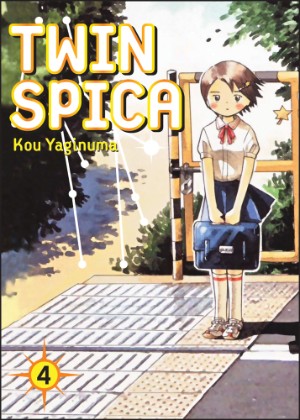
Manga Spotlight: Twin Spica
Volumes 4-8
by Kou Yaginuma
Released by Vertical
Twin Spica has started striking me a bit like Azumanga Daioh, a popular comedy manga that sought to capture the spirit of high school’s in between class moments, only more serious and ambitious.
The newer volumes of Twin Spica haven't shaken my earlier assessment. It follows the efforts of a minimalisticly rendered, cherubically illustrated thirteen year old girl as she endeavors to become an astronaut. Up until its conclusion in 2009, the manga was serialized in Japan in Comic Flapper, a seinen anthology for males in their upper teens (or older). It's a little girl working to realize her dreams of going into space. You might be in high school, or college or on the job, working toward something of dubious significance, but here's a girl giving it her all to rocket out of Earth's atmosphere.
I still think that that is how Twin Spica appeals to its reader. However, I no longer think that it's also the engine for how the manga progresses. It's not that the manga is without machinery stamping out its chapters. It's that that machinery is defined by its exhaustibility, and in that the manga is driven by rarer, more ambitious and more impressive mechanisms.
For a contrast, look at Blade of the Immortal. The premise is Manji, after being granted a sort of punishing immortality, promises to kill a thousand evil men to atone for the hundred good men he killed, and, in order to do this, he commits to assisting Rin taking revenge on the renegade swords school that brutally killed her parents. There's a definite end, but "I'll be the pirate king" is a defined end too. In the middle, there's always room for one more adversary or encounter, such that the manga can run as long or as short as is dictated by some sort of consensus between the artist, the editor and the audience’s attention. Here, Blade of the Immortal's Hiraoki Samura was talking about wrapping up Blade of the Immortal a decade ago.
While Twin Spica may have looked like it initially, it isn't a serial of dream threatening obstacles. There are still tests and tasks but those serve as opportunities to get to what the manga is really driving at.
The course here is set by XYZ axes. One axis is that dream to go into space. If there's a limit there, it's unknown and that big hope for something grand, maybe impossible is the hook for the manga.
The others are more close, and deep and interesting for those bindings.
First, there's the bond between Asumi Kamogawa and her confidants. The manner in which this is both knotted and untangled on the page is impressively planned. Asumi is thrown together with these people during her entrance to an astronaut training academy in the course of one of those early make-it or break-it challenges. That these folks are going to bond is anything but surprising, and yet, it's not simply oh, Marika is going to defrost a bit and Shu is going to drop his superior grin and join the crowd. "Wow, Asumi can do X! She saved my bacon! Why don't we be friends now?!"
Rather than Asumi simply proving herself to these people, what Twin Spica does is chart the hopes and histories of these other, fully realized characters, and, at the same time, develops the way that these people complement each other. This is impressively planned and meted out, as if Kou Yaginuma started with a real survey of the character landscape and then mapped that onto the long term plans for the manga such that the territory was revealed with credible, effecting timing. I suspect that unlike a Blade of the Immortal, Yaginuma couldn't work an Twin Spica over a dynamic span. Maybe it could be shut down early if needed, but it read too planned to be open ended. With a broad view that earns Twin Spica the adjective "novelistic" for more reason that just posessing a long story, secrets are kept or revealed, connections are made when it's true to the characters.
The other defining parameter of the manga is nostalgia. I always credited nostalgia's importance in Twin Spica. I was thinking of the reader's nostalgia for their big, probably unrealistic dreams, unbound by a day to day grind. However, nostalgia is also a key element within Twin Spica itself. There's references to the dreams that its adult characters have. And, Asumi and her peers anticipate their own nostalgia. Part of the reaction to the closure of a beloved planetarium is considering how its loss will feel from a distance, after the area has moved on and been redeveloped. Like in Azumanga Daioh, Asumi's experience at school is underscored by the fact that that the stage of life and its accompanying relationship with her peers is finite. There's a known, demarcation line, after which everything changes. There's no reason a young audience couldn't or shouldn't read and appreciate Twin Spica. However, I suspect that the manga is written more for people who remember their dreams and, if they are aren't feeling a bit of nostalgia, are precariously close to that position. Loss, connection, and limits are as responsible for the manga's power as its big dreams.
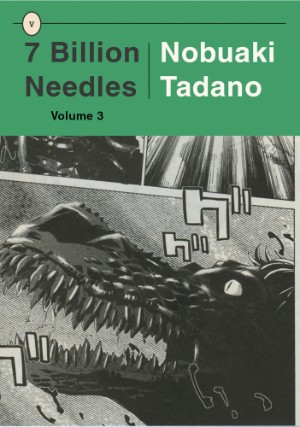
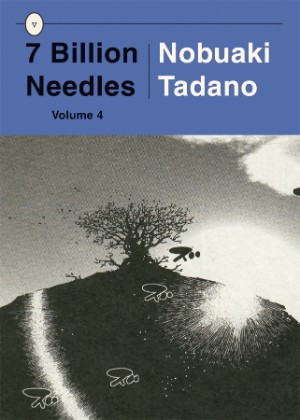
Manga Spotlight: 7 Billion Needles
Volumes 3 - 4
By Nobuaki Tadano
Released by Vertical
I suspect had 7 Billion Needles not been promoted as an adaptation of a Hal Clement golden age sci-fi ( it's been nominated for the Best Adaptation Eisner Award), I may have still suspected that it was in fact an adaptation. Early on, the work to alloy the alien symbiosis/man hunt concept of the original with the teen trouble tradition of manga, and the sci-fi spectacle of other visual media (anime and movies mostly) is evident. However, the manga eventually succeeded in this effort and began feeling like its own story.
7 Billion Needles goes into its second half with its plot and its subject's problems looking near solved and winds up veering into territory that is at once very familiar and very strange. Think of a lot of fairy tale-ish stories. In the first half the heroine encounters a through the looking glass world. That's comparable to 7 Billion Needles' sci-fi as metaphor stance. A self-isolated girl joins with a symbiotic alien and as she experiences life from that new joined , to overload the word, alien, perspective, she is prompted to engage the world in order to ferret out a second, far more dangerous extra-terrestrial. Some genuinely unexpected turns then set up the second half to the fairy tale. Having seen her world recast, in frantic rewind, the heroine rushes to retrace her process, fixing the troubles that she spotted on the way in.
Early on, 7 Billion Needles was reminiscent of other media, and as it cast thought elsewhere, it did the manga few favors. Fortunately, the coherences, and is instead, the manga becomes, sometimes reminiscent of other stories. That's less of an issue. In a bit of traditionalism complements the manga's objectives, and steadies a statement punctuated by some truly disconcerting sci-fi spectacles. Properly scaled, displaced dinosaurs are nice enough and Nobuaki Tadano proves to have a head and pen for them, but a spider/moth hybrid or a kill-it-with-fire worst mutated duck you've ever seen really puts an exclamation mark on 7 Billion Needles' more desperate moments. With a central metaphor that works, covered there and back again over a quick four volumes, 7 Billion Needles ultimately proves be a potent personal odyssey.
.jpg?1309053967)
Manga Spotlight: Gantz
Volume 16
by Hiroya Oku
Released by Dark Horse
Ironically, the back of the book synosis opens with the statement "it's hard to tell who the heroes and villains are in Gantz these days." It's a valid comment in that for the first time, Gantz's iconic black skin-tight suit glad participants are fighting each other in earnest. It's not so much off the mark as tangential to it, in that the relative moral merit of those two faction couldn't be more apparent.
Gantz's shift from its "Red Phase" to its "Blue Phase" has meant a swap in the color used in the background of its covers, a bit of turn in a direction of the story, and a big swing in the nature of the sci-fi action series. Before peer pressured into stepping in front of an express train to save a homeless man resulted in his death, teen malcontent Kei Kurono wasn't exactly a shining example of humanity's best angels. Being resurrected, given sci-fi weaponry and told to exterminate pods on aliens on the streets of Tokyo didn't instantly improve him either. However, compared to the field, his overinflated and unjustified self regard wasn't too bad. A whole lot of brutal business rains down on the just and the unjust a alike, where humanity is populated largely by the latter. Gantz defined its first dozen or so volumes with this abrasive approach, paring harsh, body rendering violence with harsh characterizations. In light of the "Blue Phase," it was a curious decision to do that first. The gruesomeness of Gantz' violence could have been a turn off or appealing given the tastes of the manga reader. And, its misanthropy could have been intriguing, I was certainly interested to see the manga go down a sort of anti-wish fulfillment route, but it also could have similarly been audience alienating.
That there are villains and intensely unlikable people in this Blue Phase is nothing new to Gantz. A characters whose entre into the sci-fi action was going on a mass-murder shooting spree finds himself a pack of underlings in a gang of rapists. That Gantz has heroes and heroism not entirely new to the Red Phase. That they're not the rare exception is the radical new norm from the Blue Phase. Kei Kurono is valiantly, self-sacrificingly fighting to protect his girlfriend, and recognizing the merit in this and in his leadership, a group of other Gantz participants similarly risk their lives. There's a bullied teen who develops psychic powers, including the ability to kill the world's wrong doers... due to moral compunction, it's not something he's entirely morally at peace with. There's a martial artist after the fashion of video game characters like Street Fighter's Ryu. There's a late middle age man who despite being totally unexceptional, is exceptionally able to mentally handle this Gantz business. They throw their lot in with Kei, in part because some believe that he represents the best chance to surive, but beyond an exercise in game theory, because they're the good guys. Much of volume 16 is spent developing. It seems like, not because like prior Gantz exercises it's going to turn around and shockingly kill them off, but because we're supposed to invest some support. Earlier character chapters served a purpose like the slack that set up the punch of the oncoming devastation - Hwang Jang Lee waving his hands before whacking Jackie Chan with a shadowless punch. Maybe it's setting the reader up for an even harder kidney shot, but it seems to be planting its feet for something more concerted. There's some exciting potential in the notion of Gantz having a core of heroes for who can consistently put on a good fight and not just get slaughters.
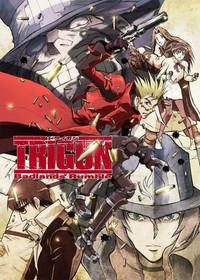
Guest Anime Spotlight: Trigun: Badlands Rumbles
Review By Johnno
Screening in American theaters this Summer
To be released on DVD/Blu-ray by FUNimation September 27th
I took the opportunity to attend a 1-day 1-time only screening for Trigun here in select theaters across Canada. While Funimation was kind enough to make this happen, I fear that having it during a Wednesday in the middle of the week isn’t that helpful for allowing a good number of fans to attend such viewings, despite that they might be the best accommodating timetable for theaters who don’t care enough to screen anime films. Especially ones that aren’t widely advertised or released by Disney, and especially aren’t dubbed. There were only around 10 or so people when I attended. I’m sure more wished they could go, I know I personally wanted to watch Evangelion 2.0 when it released for a similar 1-day 1-time only screening last year, but I couldn’t due to working late... I still appreciate that Funimation at least did this much and I will try my best to support future showings of other films I’m interested in.
This review is based on the Japanese language English subtitled version. I personally prefer the dubbed version of the Trigun series and I can’t wait to see what how the dub for the film turns out. There were quite a few older people than younger folk in the audience I watched it with. I suspect it is because the Trigun series is probably better known amongst anime fandom during the 90s, so this particular film has been a long time coming… The theater screened the movie from a Blu-ray disc as it seems is typical for screenings of this sort. But the picture looked great blown up which is a testament to the quality of Blu-ray discs and it’ll certainly be the format I’ll pick this up on when it inevitably releases. Shilling for Blu-ray aside, the animation quality of the Trigun film isn’t anything amazing or fluid compared to other theatrical feature films, even anime ones; but it is much much better than that of the original made-for-TV series, as is to be expected for a film! So on that front Madhouse did a good job updating Trigun’s animation while still retaining much of the trademark wacky style that made the series so well loved. All the Trigun-style design work from the locales to the characters to the weapons to the use of Double Dollars as currency is all faithfully maintained here, but now with higher production values. But as I mentioned, it’s not as big a quality shift from the original series, or at least it doesn’t feel that way as compared to… say… the quality of the Rebuild of Evangelion films versus its original series… But this is in no way an issue. The film looks great, the animation is better while literally evoking the same style and feel of the series almost as if it were made around the same time. Fans of Trigun will instantly feel at home and love everything about it from a production point of view.
But some expectations should also be set… The film’s story takes place in between the series, which is a sensible decision, given it’s the first Trigun film and one would want to take the opportunity to use all of its famous characters as it reasonably can. So we of course have Vash the Stampede who’s the same over-friendly, over-dramatic, womanizing, crybaby, hilariously skilled gunman we know and love. Meryl & Milly also return, as does Nicolas D. Wolfwood. Also that cheeky black cat... Given the timeframe of the film, Vash is still on the search for Knives and as of yet has not gone through the events that the Gung-Ho Guns put him through which escalates towards his final confrontation with Knives that the TV series covers. So the film’s plot does not reach anywhere near the same crescendo of emotion and turmoil that the latter half of the series covers. In fact the film ought to be best approached as a standalone episode of the series prior to the events that really bring Trigun’s story, and Vash the Stampede’s past and raison d’être, to the forefront. There is no mention of Rem or Knives or anything about why Vash is a wanted man. Newcomers whose first introduction to Trigun might be this film will be left out of the loop on a lot of details that only fans who know the series will appreciate. However, the film on its own is still enjoyable and could very well make newcomers interested in checking out the classic series, or the manga for that matter. I’d personally recommend that the film is best enjoyed by those who’ve at least watched the first half of the series past Wolfwood’s introduction in order to best enjoy the film, which is ideally not really some epic standalone story, but rather more like a good lengthened episode from the series.
That out of the way, the story of Trigun Badlands Rumble involves Vash chasing after a criminal he let escape 20 years in the ago known as ‘Gasback’ who is a master thief obsessed with pulling off the perfect robbery. On the journey he encounters ‘Amelia’ a beautiful femme fatale who is also chasing after Gasback along with hundreds of other bounty hunters. They arrive in the town of Macca City that Gasback is rumored to be targeting as a personal vendetta against the mayor who was once a criminal who betrayed him during a heist. Amelia has a more personal score to settle with Gasback and is annoyingly followed by Vash who has set his sights on wooing her. Meryl and Milly also show up in town on an immediate assignment that takes them off their duties of following Vash to immediately address the situation of the town’s safety considering that one of the town’s iconic and gaudy monuments is insured for a ridiculously high amount and their insurance company is worried about have to pay the sum if tension in the city escalates.
Everything you love about Trigun is here, from the humor, to the plants, to the sand steamers, to the gun fights, to a cast of colorful villains and low-lives. The story also once again thematically challenges Vash’s stubborn idealism for protecting lives at all costs and not allowing significant harm to occur to anyone around him, including the antagonists. Because Vash allowed Gasback to live, many others have suffered as a result of his refusal to halt a known and dangerous criminal permanently when he had the chance. Now Vash has the responsibility to set things right, but how will he handle it and face the consequences of his actions?
Badlands Rumble is well written and filled with Trigun nostalgia from beginning to end. If you’re a fan of Trigun, the film is not to be missed! If you haven’t ever seen Trigun, the film could be a great preview of what the TV series contains, though it’s better appreciated with the series in hindsight. One wonders if this could open the door to more Trigun films, but how much more can they develop Vash if they stick to more stories within the series? One hopes for the possibility that a new film could be made following the end of the series… I’m definitely open to it! We missed you Vash ol’ buddy! Here’s hoping we’ll see you again!
AICN Anime on Tumblr

